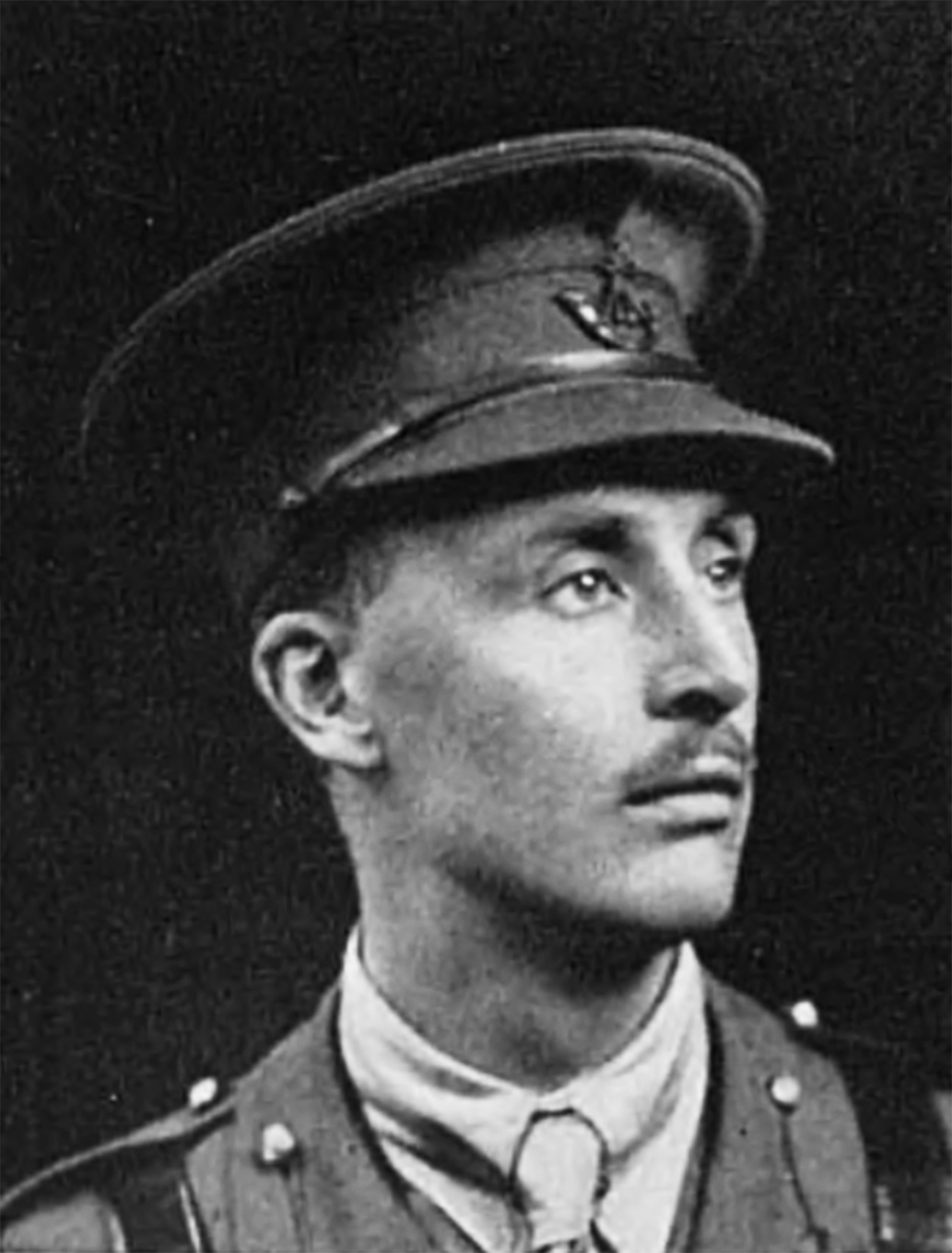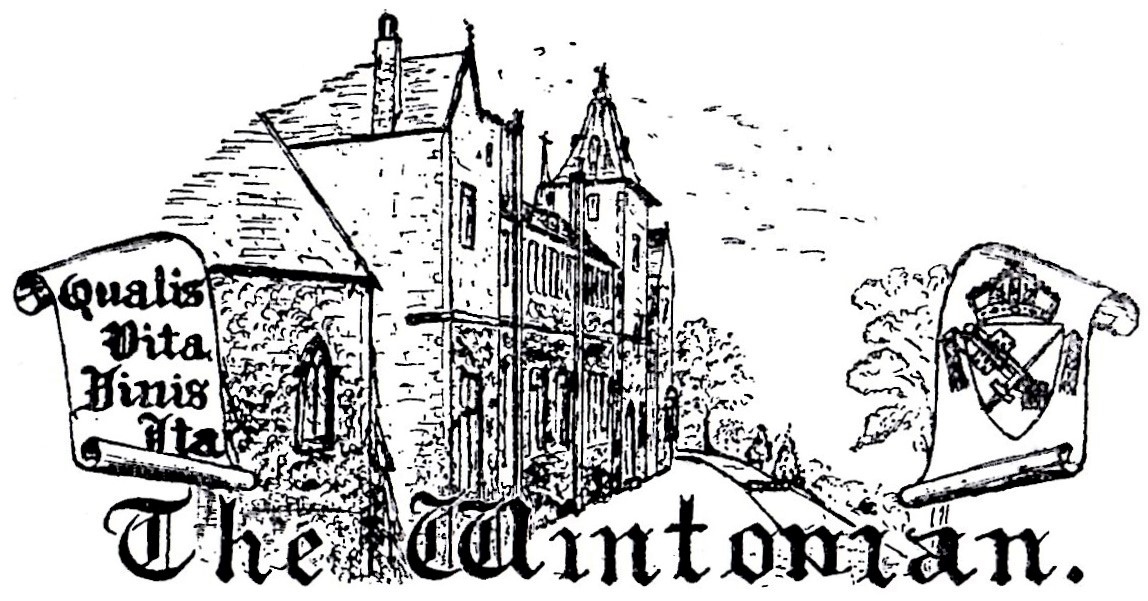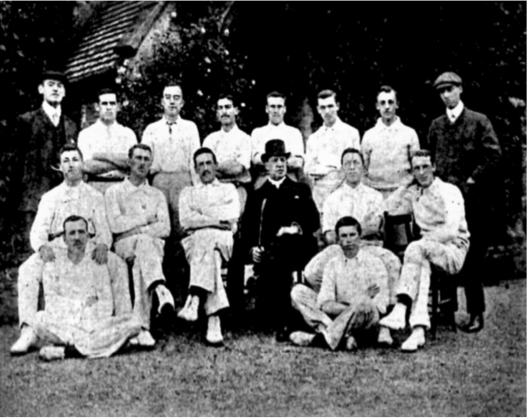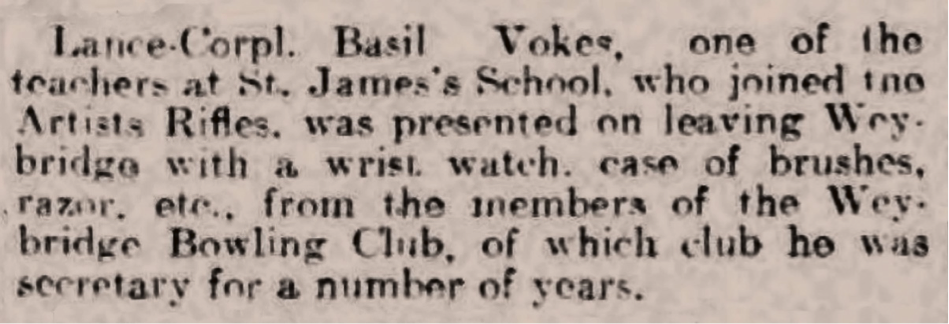Basil Vokes
4th July 1883”15th February 1917
Second Lieutenant Basil Vokes of the 1/4th Battalion, Oxford and Buckinghamshire Light Infantry was killed in action on 15th February, 1917 in France.
Family and Home Life
Vokes is an old Hampshire surname, and Basil’s family are to be found in the County. His mother’s family is from the Isle of Wight, which was part of Hampshire until 1890.
The early history of the family is difficult to trace, partly due to the ubiquity of Vokeses in the area. Basil’s mother, Lavinia (née Draper) was the fourth of six children of labourer Mark Draper and his wife Jane (née White). Born in the Spring of 1854 at Chale, Isle of Wight, at the age of 16 she became a live-in housemaid to a Late Captain Hants Militia and Landowner’ who lived at 4 City Road, Winchester. Her position presumably brought he into contact with Basil’s father, James.
Greenhill Road (top) with many landmarks familiar to College students over the years”though perhaps not the Union Workhouse on Oram’s Arbour. OS Six-Inch Series map circa 1894. Reproduced with the permission of the National Library of Scotland.
He was born in the Autumn of 1851 in Winchester. His father’s name, also James, appears on his marriage certificate but attempts to trace him in other documentation have so far failed. James junior married Lavinia on Thursday, 8th January, 1879 in Chale. The newly wedded couple settled in the first house in the newly-built Greenhill Road in the Fulflood1 area of the city. A little over one year after the wedding, a son Harold was born.
James is recorded in the census of 1881 as a Stonemason Journeyman’. Living in the house with Lavinia, Harold and him, was a visitor, an Artist in Fine Arts’, Claude de Neuville. It would be easy to assume some connection between the trades of stonemason and possibly Claude as a sculptor, but this appears not to be the case. Claude was probably in Winchester to visit his fiancée, Hannah Taylor, whom he was to marry in Winchester in the Summer of that year.2
On 4th July, 1883 Basil was born. The 1891 Census simply lists the family of four in the same location, though they had moved from number one to number nine. James’ occupation has dropped the Journeyman’ qualifier. This indicates he was now skilled and fully qualified in his trade; journeyman signalled that he was paid by the day while still learning his craft. He is also marked as Employed’ (an innovation in this census”options were Employer, Employed or Neither). Harold and Basil (11 and 7) are listed as Scholars’. They attended St. Thomas’s School3 in Mews Lane. The school later (1896) became the Practising School for Winchester Training College and Basil would in time return to his childhood school for teaching practice.
By 1901 we find the four members of the family in 3 Clifton Terrace. Home was an elegant and spacious early-Victorian house, spread over five floors. The family had acquired a General Domestic’”a twenty-one year-old Londoner by the name of Emily Kervell. Lavinia’s mother, who had been widowed nine years previously, was living with them.4 Harold, age twenty-five, is listed as a ‘Sec Div Clerk Gn P Office’. The London Gazette records that he passed his examinations to become a Clerk of the Second Division of the General Post Office on October 3rd, 1899.5 Basil, age 17, is recorded as being a Pupil Teacher Nat School’. 6 This would have been St Thomas’s School.
His job as a pupil-teacher shows that Basil had shown promise in his classwork and that he was a reliable and trustworthy child. The school would have invited him to continue beyond his usual leaving date, and effectively become an apprentice in the teaching profession.
The start of a new business venture for Basil’s father. This is the first of many regular advertisements placed in the Hampshire Chronicle. It is from the edition published on Saturday 6th September, 1902. The business is still in existence [2018].
This was a time of change in English education, in particular for pupil-teachers. In 1900, Robert Laurie Morant, advisor to the Privy Council on Education, recommended tightening up regulations for pupil-teachers. The the minimum age was raised to fifteen”except where authorised usually in rural areas. To be accepted for a position, they must be approved by an HMI, pass a medical examination, and pass written or oral examination set by the Board of Education in Reading and Recitation, English, History, Geography, Arithmetic, Algebra, Euclidean Geometry (boys) or Needlework (girls), and Teaching.
Pupil-teachers were not to be allowed to teach more than five hours per day or twenty per week. They were to be examined annually by HMI. When their term of service was completed they could sit the Queen’s (King’s from January 1901) Scholarship exam. A 1st or 2nd class pass in this qualified the holder to enter training college, although it didn’t guarantee it as applicants were far more numerous than places”in 1900 only 44.5% of eligible pupil-teachers were accepted.7
Basil completed his time as a pupil-teacher, successfully negotiated the King’s Examinations and, at the age of 19 in 1902, made the quarter-mile journey to Winchester Training College. Unsurprisingly, he was the most local of all the Alumni on the College Memorial Roll. As may be seen by the following advertisement, September 1902 was a time of change for his father, too.
Training at Winchester Training College
1902“1904
The pages of the Wintonian magazine from Basil’s time carry a series of reports on school visits made by the students. Basil contributed an article as part of this, describing a visit to Mount Pleasant School.8 This was an especially large urban primary school in Newtown,9 Southampton, which had opened four years earlier.
It seems that Basil’s involvement in the sporting events at College, which constituted a large part of the recreational side of student life, was primarily in making sure of fair play. The Wintonian records that in November of his second year, he was the referee in a football match. He was also a linesman for the Past versus Present’ (old boys) football match. Team photographs from the period also show him in the same role: twice as a football official and once as a cricket umpire, and always wearing the same cap (back right).
Six of Basil’s contemporaries at College would eventually join his name on the Memorial Roll: Albert Beaumont, Andrew Bogie, Robert Ferguson, George Hewitt, William Hicks and Harry Payne.
At the conclusion of his studies, Basil is recorded as securing a teaching position at St. James’s School, Weybridge, Surrey. Leafy’ is an epithet often applied to Surrey and, in this case, quite apt: the school was surrounded by tree-lined fields on three sides.
In Basil’s first year of teaching he would receive the news that his brother Harold died, aged 25. Three years later, in the first week of his fourth school year, he would hear of his mother’s death, aged 54. His only remaining family was his father, and his death would follow in 1913, aged 62, leaving Basil with no living close relatives.
His life in Weybridge was evidently busy. Apart from his teaching duties, he became Honorary Secretary of the Emly Deanery Schools Football League, Secretary of Weybridge Football Club, a member of Weybridge Choral Society, a member of the Freemasons, Secretary of the Bowling Club, and an N.C.O. in the local company of Volunteers.
St James’s School, Bakers Street, Weybridge Courtesy of Francis Frith. All rights reserved10
In his early years in Weybridge, he boarded with a Mrs. Summer at Fieldview, Springfield Meadow, until 1911 when she died. He then boarded at 11 Minorca Road, with Ellen Huband, headmistress of the St James’s Girls’ School.
To the Western Front
Surrey Advertiser – Saturday 08 January 1916
Basil taught at the school until War came. He enlisted in the 28th (County of London) Battalion, The London Regiment (Artists Rifles), on 1st November 1915 at the Battalion HQ in Duke’s Road, St. Pancras, London.11
The Artists Rifles was perhaps the most curious regiment in the British Army. It was formed in 1860 by a group of painters, architects, poets, sculptors, musicians and actors concerned about a possible French invasion. The Pre-Raphaelites were early members as were William Morris, Frederic Leighton and even the poet Algernon Swinburne.
The regiment was the natural choice for young men of an artistic persuasion at the outbreak of war in 1914. Artists like John and Paul Nash, the poets Edward Thomas and Wilfred Owen, and the playwright Noël Coward wore the uniform of the Artists Rifles.
In view of the calibre of men serving in its ranks, it became an officer-producing unit in 1915 and turned out over 10,000 officers for service in other regiments during the First World War.12
His medical report on joining tells us that he was 6 feet tall, weighed 154 pounds and had a 36-inch chest.
Basil was promoted to Lance Corporal on November 24th and then Corporal on 11th March, 1916. His movements over the next three months are a little uncertain. He probably followed the same course as war poet, Wilfred Own, who had enlisted in the 3/28th two months before and exited from officers’ training also two months ahead of Basil. As Artists Rifles unusually ran their own Officers Training Corps (OTC) at Hare Hall Camp in Essex, it is likely that their training overlapped there. The College War Supplement, printed in June 1916, lists him as being at O.T.C. Romford’, which was the location of Hare Hall.
All commissioned officers’ postings and changes of Regiment were posted in The London Gazette. In the 13th September 1916 edition, we find a notice of Basil being transferred from Artist’s Rifles O.T.C. to the Oxford and Buckinghamshire Regiment, and promoted to 2nd Lieutenant. Both of these were effective from 5th September.
Basil had joined the 1/4th Battalion Oxford and Buckinghamshire Light Infantry”The Lightbobs, as the Regiment was known. His new Battalion at this time were on the Somme, near Courcelette.
Throughout November and December the Battalion held the front line, were relieved, fell back to camps or billets, then moved up once more to relieve others”a familiar cycle for the men. By Great War standards, casualties were light, mainly arising from shelling and snipers.
The Winter of 1916“1917 was extremely bitter, and took its toll on the men, in morale, illness and frostbite:13
We have been having a very severe spell of cold weather. The French people say that they have not had such a frost for over 20 years. For weeks now the whole country has been covered with snow, and all the streams and ditches are covered with ice many inches thick. The cold weather is very trying for the troops. When we are in the trenches it is not possible to keep warm because it is impossible to move about very much, and it is not always possible to have much of a fire because the smoke might attract the unpleasant attractions of the enemy over the way. So we have been very cold in the line.’14
The entirety of January was spent training in various camps, with route marches between. After a dizzying itinerary of locations, on February 7th they arrived 10 miles southeast of where they had been in November, in the great crook formed by the meandering River Somme, at Herbecourt. Here they entered the trenches and, on the 9th, moved up to the front line to relieve the 1/8th Worcesters. Almost all work and movement near the front line was done under cover of darkness, and they were in position by 9.45pm.
The Battalion Diary fills in the last days of Basil’s life. It is here transcribed almost in full. Basil was in charge of C Company, which bore the brunt of the German artillery:
Feb 10th Front Line opposite La Maisonnette. Some artillery activity on our centre and left Companies between 9 and 10am. Otherwise Quiet day. 2 men in A Company wounded. Ground in trenches frozen very hard, making work extremely laborious. Enemy aeroplane over our lines several times during the day. Parties of 1/4th R. Berks up in evening to assist in improving trenches.
Feb 11th Between 8 and 9am usual enemy artillery activity, chiefly on centre Company, about 60 shells falling on the men in the hour. 1.40pm a few more shells on our trenches. 3 O.R.15 wounded by artillery during the day
Feb 12th Frost still holding. Enemy again fairly active with granatenwerfer16 and artillery between 8 and 10am and again about 3pm. Our snipers claim a hit on a German who was exposing himself in a sap. Very little aerial activity. One casualty caused by dropping a bag of French bombs17 which were being removed from the trenches.18 Patrols at night reconnoitring ground.
Feb 13th 4am. Three trees in A Company’s line blown up by Royal Engineers, it being considered by the authorities that they assisted the enemy’s artillery in ranging. Enemy artillery fairly active again, in the morning, to which our guns replied. Battalion relieved by the 1/4th Royal Berks in the early evening
Feb 14th Brigade support 1500 yards East of Flaucourt. About 10am neighbourhood of Battalion HQ shelled for half an hour. Casualties 3 OR in C Company slightly wounded. Battalion when in support finds working parties in line for Berks, also carrying parties for SAA,19 bombs, Royal Engineers materials, etc. every night. This together with constant working parties and duties, occupies the whole Battalion.
Feb 15th Brigade Support 1500 yards East of Flaucourt. 9.30am Several hostile aeroplanes over, which were strafed’ by our Lewis gun. 10.15am Shelling in neighbourhood of Battalion HQ commenced. This continued, without cessation, till 1pm being particularly fierce for about the first ¾s of an hour. Several hundred shells were fired, principally 15cm howitzers. Several direct hits scored on dugouts occupied by Battalion HQ and C Company, also on a dump of French bombs on the road close by. Casualties: killed 2Lt. B. Vokes from a shell which burst just outside entrance to C Company’s HQ, and 1 OR. Wounded 5 OR.
One unattributed obituary reports that his death was from a head wound caused by flying shrapnel.20 On 14th August, 1924, small scattered graveyards in the battle area were concentrated’ by the War Graves Commission, bringing them all to Basil’s final resting place: Hem Farm Military Cemetery. The record of his exhumation would suggest that his wounds were much more extensive and were to most of his upper body.21 It may be that a kindlier, sanitised version had been sent by letter to his next of kin. Having no surviving family, his Army and Probate records only record his executors: Arthur Macklin22 and Harry John Pafford.23 His Army records carry the following letter from Arthur Macklin:
Dear Sir,
In a further reply, there are no relatives living of the late Second Lieutenant B. Vokes as stated below, with the single exception of an uncle 24 on mother’s side, but I regret to say his address is unknown.
I should like to add that the late Second Lieutenant B. Vokes was an orphan, but made his home with my mother who was his next-of-kin. My mother however passed away in March last, and consequently all communications relating to her have been passed on to me as the eldest son
You will therefore see that the late Second Lieutenant B. Vokes having made his home with my people, he was brought up with my sister and myself.
Yours faithfully,
Edwin Macklin
Basil is also remembered on St. Thomas’s School Memorial25 (now in King’s School, Romsey Road) along with fellow Alumni who gave their lives: A.O. Bartlett, F. Bishop, A.W. Bogie, and W.F. Leach.
His body lies at Hem Farm Military Cemetery, Hem-Monacu, Somme/Picardie, France.
Researcher and Author: John Vickers
Footnotes
[1] Sometimes spelled Fullflood’. The area is to the west of Winchester Station and north of Romsey Road. Originally named Foulflood’, this neighbourhood derives its name from a stream, probably intermittent, causing floods and bringing with it debris. The name is preserved in the name of The Fulflood Arms on Cheriton Road. Source: http://www.cityofwinchestertrust.co.uk/archive/pubfulflood/origin.shtml
[2] In 1891 he was listed as an Artist in Black and White Etchings’ living with his family in Cowley, Oxford. By 1901 he was living in Clapham and described himself as a ‘Master Hairdresser’ and then Toilet Chemist’ in 1911.
[3] Thanks for this information to Geraldine Buchanan of the Great War Dead of St. Matthew’s, Weeke with St. Paul’s, Fulflood research group
[4] She died in the Spring of 1902.
[5] The London Gazette, issue October 3rd, 1899, p.6015
[6] National Schools were founded in 1811 in England and Wales by the National Society for Promoting Religious Education. They provided elementary education, in accordance with the teaching of the Church of England, to the children of the poor. Together with the less numerous British Schools of the British and Foreign School Society, they provided the first near-universal system of elementary education in England and Wales. From 1833 both systems were supported by Government grants which provided partial funding. They were eventually absorbed into the state system, either as state-run, or faith schools entirely or partly funded by the state (VA and VC schools).
[7] Source: History in Education Project, Institute of Historical Research, University of London by Jenny Keating, December 2010 https://www.history.ac.uk/history-in…in…/teacher_training_-_up_to_the_1960s.doc
[8] Mount Pleasant, opened February, 1898, for 1,223 children; average attendance, 266 boys, 232 girls & 212 infants; H. Russell, master; Miss J. C. Barnes, mistress; Miss M. C. Darling, infants’ mistress. Source: Kelly’s Directory of Hampshire and the Isle of Wight, 1898, p.436
[9] Newtown was not a recent development. It was given its name in 1250.
[10] https://www.francisfrith.com/weybridge/weybridge-the-schools-1906_55649
[11] See Surrey Advertiser article Saturday 08 January 1916, above
[12] The National Army Museum https://www.nam.ac.uk/whats-on/artists-artists-rifles
[13] Image: British Red Cross motor convoy halted on a roadside in the snow, 1916. IWM Q51945. https://www.iwm.org.uk/collections/item/object/205285584
[14] Somewhere in Flanders: Letters of a Norfolk Padre in the Great War, Rev. Leighton Green.
[15] Other Ranks: Privates and Non-Commissioned Officers. Unusually they are named: Pte. P Gardner, Pte HG White and Pte J Smith
[16] A 400g grenade launched from a portable platform. It was propelled from the small launch pad by a blank rifle cartridge, giving the grenade a much greater range than a hand grenade”up to 300m.
[17] French bomb: A small stick-bomb similar in use to a hand grenade
[18] Pte. E Eyels. Later died of these wounds
[19] Small Arms Ammunition, i.e. rifle and machine-gun rounds
[20] http://www.surreyinthegreatwar.org.uk/people/page/10/?s=ham&search=1
[21] Special Exhumation Report. The brutal description reads Head, chest arms badly smashed’
[22] Arthur Macklin, Headmaster in Christchurch, Hampshire in 1911. He was born in Winchester and a contemporary of Basil’s father
[23] Harry John Pafford, Bank Clerk in Christchurch, Hampshire in 1911. Relationship to Basil is unknown.
[24] He had three surviving maternal uncles at this time: Frank, Martin and Arthur Draper.
[25] St. Thomas’s was a Practising School’ for the College, where students would learn practical classroom management and teaching techniques. It therefore carries a number of names of Alumni.
Sources
Ancestry (2018). Home page. [online] Available at: www.ancestry.co.uk [Accessed 2018]/
British Newspaper Archive (2018). Hampshire Chronicle. Saturday 6th September, 1902. [online] Available at: www.britishnewspaperarchive.co.uk [Accessed 2018]/
British Newspaper Archive (2018). Surrey Herald, Issue No. 4043, 23 February 1917, p.4 , Col f. [online] Available at: www.britishnewspaperarchive.co.uk [Accessed 2018]/
British Newspaper Archive (2018). Surrey Herald, Issue No. 4044, 2 March 1917, p.4 , col.f [online] Available at: www.britishnewspaperarchive.co.uk [Accessed 2018]/
British Newspaper Archive (2018). Surrey Comet, Issue No. 4128, 28 February 1917, p.7 , col.e. [online] Available at: www.britishnewspaperarchive.co.uk [Accessed 2018]/
The City of Winchester Trust (2018). Neighbourhood Studies No. 1 – Fulflood [online] Available at http://www.cityofwinchestertrust.co.uk/archive/pubfulflood/origin.shtml [Accessed 2018]/
Commonwealth War Graves Commission, (2018). Home page. [online] Available at www.cwgc.org/ [Accessed 2018].
Francis Frith (2018). Weybridge, The Schools 1906. [online] Aavailable at https://www.francisfrith.com/weybridge/weybridge-the-schools-1906_55649 [Accessed 2018].
Green, L. (2005). Somewhere in Flanders: Letters of a Norfolk Padre in the Great War. Norfolk : Larks Press.
Imperial War Museum (2018). Image IWM Q 51945. [online] Available at https://www.iwm.org.uk/collections/item/object/205285584 [Accessed 2018].
Kelly’s Directory (1898). Kelly’s Directory of Hampshire & Isle of Wight, 1898. [online] Available at: http://specialcollections.le.ac.uk/cdm/ref/collection/p16445coll4/id/218262 [Accessed 2018].
The London Gazette. (2018). The London Gazette, issue October 3rd, 1899. [online] Available at: www.thegazette.co.uk [Accessed 2018].
National Army Museum (2018). The artists of the Artists Rifles. [online] Available at: https://www.nam.ac.uk/whats-on/artists-artists-rifles [Accessed 2018].
National Union of Teachers. (1920). War Record 1914“1919. A Short Account of Duty and Work Accomplished During the War. London: NUT.
Rose, M. (1981). A history of King Alfred’s College, Winchester 1840-1980. London: Phillimore.
Surrey in the Great War (2018) Army search results. [online] Available at http://www.surreyinthegreatwar.org.uk/people/page/10/?s=ham&search=1 [Accessed 2018].
| University of Winchester Archive “ Hampshire Record Office | ||
| Reference code | Record | |
| 47M91W/ | P2/4 | The Wintonian 1899-1900 |
| 47M91W/ | P2/5 | The Wintonian 1901-1902 |
| 47M91W/ | P2/6 | The Wintonian 1903-1904 |
| 47M91W/ | P2/7 | The Wintonian 1904-1906 |
| 47M91W/ | P2/8 | The Wintonian 1905-1907 |
| 47M91W/ | P2/10 | The Wintonian 1908-1910 |
| 47M91W/ | P2/11 | The Wintonian 1910-1914 |
| 47M91W/ | P2/12 | The Wintonian 1920-1925 |
| 47M91W/ | D1/2 | The Student Register |
| 47M91W/ | S5//5/10 | Photograph of 5 alumni in Mesopotamia |
| 47M91W/ | Q3/6 | A Khaki Diary |
| 47M91W/ | B1/2 | Reports of Training College 1913-1914 |
| 47M91W/ | Q1/5 | Report and Balance Sheets 1904- 1949 |
| 47M91W/ | R2/5 | History of the Volunteers Company 1910 |
| 47M91W/ | L1/2 | College Rules 1920 |
| Hampshire Record Office archive | ||
| 71M88W/6 | List of Prisoners at Kut | |
| 55M81W/PJ1 | Managers’ Minute Book 1876-1903 | |
| All material referenced as 47M91W/ is the copyright of The University of Winchester. Permission to reproduce photographs and other material for this narrative has been agreed by the University and Hampshire Record Office. | ||









